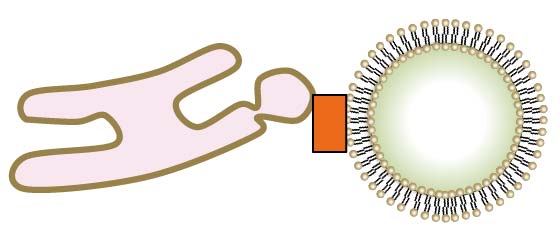Detail Information of Protein
This page represents the original version, and you may click to view the latest version: Version 2.0
Basic Information:
| Symbol | VAPB |
| Synonyms | UNQ484/PRO983 |
| Protein Name | Vesicle-associated membrane protein-associated protein B/C (VAMP-B/VAMP-C) (VAMP-associated protein B/C) (VAP-B/VAP-C) |
| Species | Human |
| Entrez ID | 9217 |
| Uniprot ID | O95292 |
| Membrane Contact Site |
ER-Endosome; Endosome-ER

|
| Location (from literature) | ER |
| Cell line/Tissue | HeLa cells; COS-7 cells; MelJuSo cells; HEK293T cells |
| Experimental Method | Low throughput experimental methods |
| Protein Sequence | |
| More related results |
Complex Information:
| Complex ID | Subunit of complex | Subcellular location | Species | More |
| CMCS00008 | VAPA; VAPB; SNX2 | ER-Endosome; Endosome-ER | Human | more | CMCS00009 | VAPA; VAPB; OSBP; PI(4)P | ER-Endosome; Endosome-ER | Human | more | CMCS00011 | VAPA; VAPB; OSBPL1A | ER-Endosome; Endosome-ER | Human | more | CMCS00023 | VAPA; VAPB; STARD3 | ER-Endosome; Endosome-ER | Human | more | CMCS00024 | VAPA; VAPB; STARD3NL | ER-Endosome; Endosome-ER | Human | more | CMCS00026 | VAPB; VAPA; VPS13C | ER-Endosome; Endosome-ER | Human | more | CMCS00027 | VAPB; VAPA; OSBPL1A; RAB7A; RILP | ER-Endosome; Endosome-ER | Human | more | CMCS00167 | OSBPL10; OSBPL9; VAPA; VAPB; PI(4)P | ER-Endosome; Endosome-ER | Human | more |
Expression Overview of VAPB:
Homology Information of VAPB:
| Uniprot ID | O95292 |
| EggNOG | KOG0439 |
| HOGENOM | CLU_032848_0_1_1 |
| OrthoDB | 122649at2759 |
| TreeFam | TF317024 |
| GeneTree | ENSGT00940000155769 |
References:
| Pubmed ID | 27419871 |
| DOI | 10.1016/j.cell.2016.06.037 |
| Description | Endosome-ER Contacts Control Actin Nucleation and Retromer Function through VAP-Dependent Regulation of PI4P. |
| Description of experimental evidence | The protein was validated by TALENs, fluorescence microscopy, western blotting and phosphoinositide analysis in HeLa cells, COS-7 cells, and these results reveal a role of PI5P in retromer-/WASH-dependent budding from endosomes. |
| More related results |
| Pubmed ID | 24105263 |
| DOI | 10.1242/jcs.139295 |
| Description | STARD3 or STARD3NL and VAP form a novel molecular tether between late endosomes and the ER.The ER interaction partners of STARD3 and STARD3NL in LE-ER MCS are VAP-A and VAP-B. |
| Description of experimental evidence | The protein was validated by immunoprecipitation, electron microscopy, immunofluorescence, in situ proximity ligation assay, mSDS-PAGE and western blot analysis in HeLa cells. |
| More related results |
| Pubmed ID | 28377464 |
| DOI | 10.15252/embj.201695917 |
| Description | Corroborating this, in vitro reconstitution assays indicated that STARD3 and its ER-anchored partner, Vesicle-associated membrane protein-associated protein (VAP), assemble into a machine that allows a highly efficient transport of cholesterol within membrane contacts. |
| Description of experimental evidence | The protein was validated by immunofluorescence, colocalization analysis, filipin staining, GFP-D4, filipin co-staining, flotation experiments, electron microscopy and stereology in Hela cells, and the complex allows a highly efficient transport of cholesterol within membrane contacts. |
| More related results |
| Pubmed ID | 27270042 |
| DOI | 10.1016/j.devcel.2016.05.005 |
| Description | This sterol traffic depends on interaction between ER-localized VAP and endosomal oxysterol-binding protein ORP1L, and is required for the formation of ILVs within the MVB and thus for the spatial regulation of EGFR signaling. |
| Description of experimental evidence | The protein was validated by electron microscopy, florescence Imaging, western blotting, immunoprecipitation, and quantitative RT-PCR in HeLa cells, which has important role in the sterol traffic. |
| More related results |
| Pubmed ID | 19564404 |
| DOI | 10.1083/jcb.200811005 |
| Description | We show that cholesterol in LEs is sensed by ORP1L, which transmits this information to the Rab7–RILP–p150Glued complex through the formation of ER–LE membrane contact sites (MCSs). At these sites, the ER protein VAP enters the Rab7–RILP complex to control p150Glued binding and positioning of LEs. |
| Description of experimental evidence | The protein was validated by microscopy, FLIM, Immuno-EM and filipin stainings in MelJuSo cells, and these data explain how the ER and cholesterol control the association of LEs with motor proteins and their positioning in cells. |
| More related results |
| Pubmed ID | 34817532 |
| DOI | 10.1083/jcb.202103141 |
| Description | ORP10 localizes in a PI4P-dependent manner at ER–endosome membrane contact sites tethered by ORP9 and VAP, where it mediates countertransport of PI4P and PS. |
| Description of experimental evidence | The protein was validated by immunofluorescence microscopy, live-cell imaging, image analysis, coimmunoprecipitation and LC-MS/MS in HeLa cells, HEK293T cells and COS-7 cells. |
| More related results |
| Pubmed ID | 33124732 |
| DOI | 10.15252/embj.2019104369 |
| Description | The endoplasmic reticulum possesses three major receptors, VAP‐A, VAP‐B, and MOSPD2, which interact with proteins at the surface of other organelles to build contacts; onventional FFATs (illustrated here with STARD11/CERT) which allow the formation of a stable complex between VAPs/MOSPD2 and thus the formation of MCSs. |
| Description of experimental evidence | The protein was validated by pull‐down assays, immunoprecipitation,SDS–PAGE, western blot, CIP treatment, coomassie blue staining, mass spectrometry analysis, immunofluorescence and colocalization analysis in HeLa cells. |
| More related results |